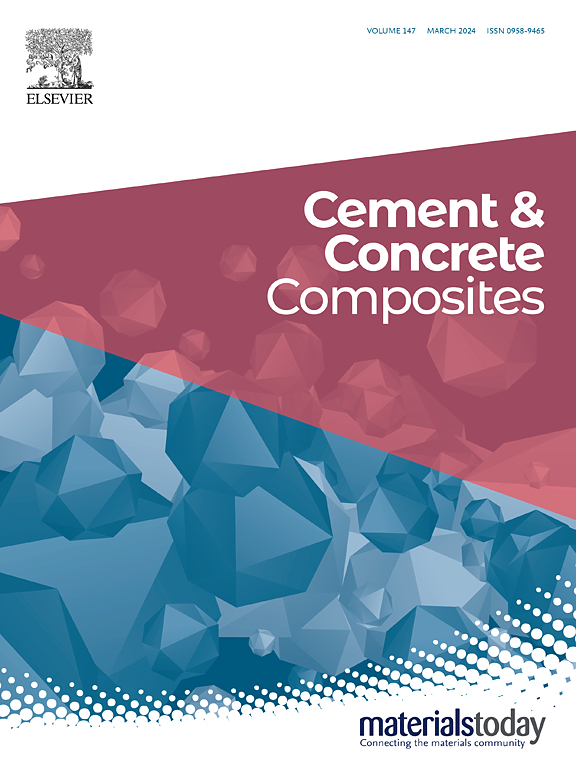通过具有扩展软化性能的应变硬化胶凝复合材料(SHCC)增强弹性体样塑性胶凝材料
IF 10.8
1区 工程技术
Q1 CONSTRUCTION & BUILDING TECHNOLOGY
引用次数: 0
摘要
失活胶凝细胞复合材料(ACCCs)在失活行为阶段表现出铰链式可恢复变形,这是胶凝材料中罕见的伪弹性特性。然而,在这一阶段,它们的低承载能力限制了它们在高负载应用中的使用。本研究采用应变硬化胶凝复合材料(shcc),采用增材制造辅助铸造技术制备了短(SHCC-SS)和长(SHCC-LS)软化尾。采用数字图像相关(DIC)的单轴压缩试验评估了它们的压缩行为、峰值强度、泊松比变化和能量耗散。预压缩后的循环试验评估了其可恢复的变形弹性,并使用数码光学显微镜检查了接缝裂缝处的纤维桥接。结果比较了参考使用纤维增强胶凝材料应变软化(SS)。与参考材料(SS)相比,使用SHCC混合物的ACCCs在压缩条件下表现出更强的承载能力和稳定的减氧行为。自接触后,它们保持负泊松比达到相当高的压缩应变,防止分裂破坏和保持结构完整性。这是因为加入SHCC可以通过促进多个裂纹的应变硬化来实现更大的关节旋转,从而延迟主裂纹的形成并减小其张开度。循环试验中,含SHCC-LS和SHCC-SS的p1型ACCCs可恢复变形弹性模量分别比SS提高4.8倍和3.0倍,SHCC-LS软化尾延长,压缩弹性优于SHCC-SS,改善了主裂缝中的纤维桥接,提高了铰缝的旋转刚度。具有初始应变硬化和扩展软化特性的SHCC混合料,使先进的塑性胶凝材料能够在不同的载荷水平上进行可扩展设计。本文章由计算机程序翻译,如有差异,请以英文原文为准。
Enhanced elastomer-like auxetic cementitious materials through strain-hardening cementitious composites (SHCC) with extended softening properties
Auxetic cementitious cellular composites (ACCCs) exhibit hinge-type recoverable deformation during auxetic behavior phase, a rare pseudo-elastic property in cementitious materials. However, their low load-bearing capacity during this phase restricts their use in high-load applications. This study developed ACCCs using strain-hardening cementitious composites (SHCCs) with short (SHCC-SS) and long (SHCC-LS) softening tails, fabricated by additive manufacturing-assisted casting. Uniaxial compression tests employing Digital Image Correlation (DIC) evaluated their compressive behavior, peak strength, Poisson's ratio variation, and energy dissipation. Cyclic tests after pre-compression assessed their recoverable deformation resilience, with fiber bridging at joint cracks examined using digital optical microscope. Results were compared to a reference using fiber-reinforced cementitious materials with strain softening (SS). Compared to the reference (SS), ACCCs using SHCC mixtures exhibit superior load-bearing capacity and stable auxetic behavior under compression. After self-contact, they maintain a negative Poisson's ratio up to a considerably high compressive strain, preventing splitting failure and preserving structural integrity. This is because incorporating SHCC enables greater joint rotation by promoting multiple cracks with strain hardening, which delays primary crack formation and reduces its opening. During cyclic tests, P1-shaped ACCCs with SHCC-LS and SHCC-SS enhance the elasticity modulus of recoverable deformation by 4.8 and 3.0 times, respectively, compared to SS. SHCC-LS outperforms SHCC-SS in compressive resilience due to its prolonged softening tail, which improves fiber bridging in primary cracks and increases rotational stiffness in hinge joints. SHCC mixtures with initial strain hardening and extended softening enable scalable design of advanced auxetic cementitious materials across various load levels.
求助全文
通过发布文献求助,成功后即可免费获取论文全文。
去求助
来源期刊

Cement & concrete composites
工程技术-材料科学:复合
CiteScore
18.70
自引率
11.40%
发文量
459
审稿时长
65 days
期刊介绍:
Cement & concrete composites focuses on advancements in cement-concrete composite technology and the production, use, and performance of cement-based construction materials. It covers a wide range of materials, including fiber-reinforced composites, polymer composites, ferrocement, and those incorporating special aggregates or waste materials. Major themes include microstructure, material properties, testing, durability, mechanics, modeling, design, fabrication, and practical applications. The journal welcomes papers on structural behavior, field studies, repair and maintenance, serviceability, and sustainability. It aims to enhance understanding, provide a platform for unconventional materials, promote low-cost energy-saving materials, and bridge the gap between materials science, engineering, and construction. Special issues on emerging topics are also published to encourage collaboration between materials scientists, engineers, designers, and fabricators.
 求助内容:
求助内容: 应助结果提醒方式:
应助结果提醒方式:


